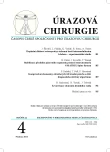Compressive fractures of thoracic spine vertebras in children: diagnosis and treatment algorithm
Authors:
Petra Dubská; Tomáš Pešl; Petr Havránek
Authors‘ workplace:
Department of pediatric trauma and surgery, 3rd Faculty of Medicine, Charles University, Prague
; Klinika dětské chirurgie a traumatologie 3. LF UK a Thomayerovy nemocnice Praha Krč
Published in:
Úraz chir. 22., 2014, č.4
Overview
Aim:
The aim of our study was to assess and optimise the algorithm of diagnosis and treatment of compressive fracture of thoracis spine in children which has been used in our department and to recommend this algorithm for professional public.
Methods:
We included 189 patients treated in our childrens’ surgery clinic with diagnosis of compressive fracture of thoracic spine over 3 years (2010–2012). The diagnosis was set on the basis of anamnesis, X-ray and clinical examination. We assessed clinical symptoms, indication of hospitalization, indication of MR, day of initiation of rehabilitaon (including verticalization) and duration of hospitalization.
Results:
MR imaging was done in 124/189 (65,6 %) of patients and in 98/124 (79 %) of cases was the fracture confirmed. One hundred-fifty-four patients (89 %) was treated during hospitalization. Rehabilitation was intiated after pan relief - 5,7 day and next day was inciated verticalization. In 125/189 (66,1 %) of patients were diagnosted multiple fractures of thoracis vertebras. Mean duration of hospitalization was 7 ± 3,6 day.
Conclusion:
Compressive fractures of thoracic spine are diagnosed on the basis of anamnestic data, X-ray and clinical examination including neurological status. The diagnosis of skeletal trauma should be completed by MR to differentiate recent compressive fractures from older injury. Patients with a new fracture need to be admitted with resting regimen. Rehabilitation and verticalization is started after pain relief.
Key words:
Compressive fracture, thoracic spine, magnetic resonance, etiology, treatment algorithm.
Sources
1. CARREON, LY, GLASSMAN, SD, CAMPBELL, MJ. Pediatric spine fractures: a review of 137 hospital admissions. J Spinal Disord Tech. 2004, 17, 477–482.
2. CIRAK, B., ZIEGFELD, S., KNIGHT, VM. et al. Spinal injuries in children. J Pediatr Surg. 2004, 39, 607–612.
3. HAVRÁNEK, P. Dětské zlomeniny. 2. vyd. Praha: Galén, 2013. 378 s.
4. JOUVE, JL., BILLINI, G., PANUEL, M. et al. Traumatismes du rachis de l‘enfant. EMC Appareil Locoteur. 1999, 15, 815.
5. LEROUX, J., VIVIER, PH., OULD SLIMANE, M. et al. Early diagnosis of thoracolumbar spine fractures in children. A prospective study. Orthop Traumatol Surg Res. 2013, 99, 60–65.
6. MAGERL, F., AEBI, M., GERTZBEIN, SD. et al. A comprehensive classification of tho-racic and lumbar injuries. Eur Spine J. 1994, 3, 184-201.
7. SALGADO, A., PIZONES, J., SACHEZ-MARISCAL, F. et al. MRI reliability in classify-ing thoracolumbar fractures according to AO classification. Orthopedics. 2013, 36, 75–78.
Labels
Surgery Traumatology Trauma surgeryArticle was published in
Trauma Surgery

2014 Issue 4
- Metamizole vs. Tramadol in Postoperative Analgesia
- Metamizole at a Glance and in Practice – Effective Non-Opioid Analgesic for All Ages
- The Importance of Hydration in Wound Healing
- Obstacle Called Vasospasm: Which Solution Is Most Effective in Microsurgery and How to Pharmacologically Assist It?
- Possibilities of Using Metamizole in the Treatment of Acute Primary Headaches
Most read in this issue
- Compressive fractures of thoracic spine vertebras in children: diagnosis and treatment algorithm
- External fixation of distal radius fractures
- SUPPLEMENTATION OF OSTEOSYNTHESIS OF FEMUR BY AN INTERMEDULLARY NAIL – EXPERIMENTAL STUDY
- Stabilisation of the anterior pelvic ring segment by ©MATRIX Spine System
